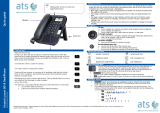2 Client check-in
2.1 Registering a client when he checks-in.
When a client arrives, select a free and cleaned room.
Hotel (Hotel programmed key).
Select the key corresponding to a free room or enter the number of a free room.
According to the sequence of screens, you must:
1. Enter the 'empty' fields (client name, for example).
2. Modify the fields which do not correspond to the default values (language, for example).
3. Validate all the check-in screens as you go along.
The validation (OK key) of the last screen quits the CHECK-IN. The room is then considered occupied, a
'Client Information Ticket" is printed automatically.
Access to the Hotel function is via an 'Hotel' programmed key. This key can be a key on the 'Perso'
page, the 'F1' or 'F2' key, or a key on an additional module.
The following screens correspond to the check-in (a maximum of six from eight):
Deposit:
A prepayment (metering credit) is proposed by default. You can modify the amount or select
'NoPrep' (no prepayment).
The client prepayment amount is converted into a number of metering impulses (metering credit). When
his credit runs out, an audio signal warns the customer that:
- his call is about to be cut off,
- he cannot make any more outside calls,
- he is requested to make a further prepayment.
Guest's name:
Enter the client's name (8 characters max.).
Wake-up time:
A wake-up alarm time is proposed by default.
You can modify the time or select 'Clear' (no wake-up alarm).
DND:
Activate (DND) or deactivate (dnd) the 'do not disturb' feature.
Language:
Select the client's language from the possibilities offered.
Note: the language is automatically assigned to the client voice mail box and terminal (if it has a
display).
DDI number:
The client is automatically assigned a DDI no.
Select 'Choice' to assign another and then pass it on to the client.
Outside calls (Barring):
The client's line is barred by default for international calls.
Select 'Choice' to modify the terminal's barring.
Room password:
The client is automatically assigned a password.
Select 'Choice' to assign another and then pass it on to the client.






















